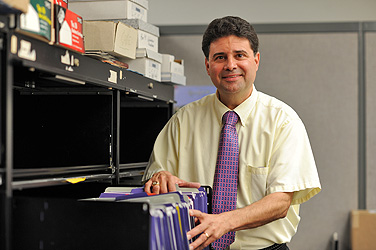Close Up
Compassionate eye for aspiring physicians

In addition to screening applications, James Rosso likes to counsel prospective medical school students on how to strengthen their admissions applications. Photo: NANCY J. PARISI
-
 Print
Print -
 Comments
Comments
-
“We look at the well-roundedness of the candidate—what they call a holistic approach.”
As admissions adviser for the School of Medicine and Biomedical Sciences, James Rosso has been gatekeeper to tens of thousands of aspiring physicians over the past 27 years, exuding what he terms the applicant-friendly nature of the school’s admission policy.
Last year, more than 4,500 applications were received for the entering class, the most received in more than 10 years. From that total, about 600 candidates were interviewed by the admissions committee to fill the 140 available slots, plus four additional slots for the combined MD/PhD program.
Rosso closely inspects each application thoroughly before passing it on to the committee. “We look at everything in the application—not just grades and MCAT (Medical College Admission Test) scores, but the schools attended, the personal essay of why they want to become a doctor, clinical experience, research experience, leadership positions, performance improvement over the years and required recommendations,” he observes.
Most medical schools use computer cutoffs in application review—if a GPA is less than 3.50 or an MCAT score is under 32, the applicant is automatically rejected. That’s not the policy at UB.
“Everyone has a chance. We’re judging qualifications,” says Rosso. “We look at the well-roundedness of the candidate—what they call a holistic approach. Sometimes candidates come for an interview with stellar academic records and stellar MCAT scores, but they don’t have the other qualities that we’re looking for in a future physician. We’re looking for a sense of compassion and empathy, communication skills, honesty and integrity, a good handle on the different problems facing health care in the future—very important qualities. All of those qualities come out in the interview process.”
By giving full consideration to an applicant and considering possible extenuating circumstances, the committee may find what they call a diamond in the rough, Rosso notes. Not that scores are any slouch here. Rosso notes that last year’s entering class averaged 3.70 GPA and 32 MCAT. “That’s the highest I’ve seen in the 27 years I’ve been here,” he says. “This year, we may even break those numbers. Right now, we’re averaging almost a 33 MCAT with a 3.74 GPA for the entering class, which is just tremendous.”
Rosso takes great pleasure in counseling applicants on how to strengthen their admission requests. Like the person who was confounded as to why he was being rejected at every medical school, even though he had top recommendations. As Rosso studied the person’s application, he suddenly was struck by the personal essay, which was written in a self-obsessed, first-person manner. After a major rewrite, the young man’s acceptance fortunes instantly changed.
Rosso relates to any applicant’s struggles, recalling his own frustrating job quest before arriving at UB in 1983. “I know how these candidates feel. How brutal it is to be rejected,” he says. “Maybe I can give back a little more compassion for those who are not successful.”
The diversity of classes has been on the rise since Rosso started, when the majority of the entering class was male. The 2008 entering class had more females than males, 75 to 60. Last year, there was a 74-66 male-female mix.
A vast range of people also figures into the equation. Rosso notes that last year’s freshman class included a person in his 40s, a former deputy sheriff for Erie County. Some years back, UB accepted the so-called oldest candidate in the history of U.S. medical schools. She was 55 years old. Another candidate who was accepted by the committee was 13, a brilliant young Californian who started at UCLA when she was 10.
Rosso’s enthusiasm for his job is infectious. Over the years, his duties have increased to include coordination of graduation and orientation of incoming freshmen.
He also coordinates six blood drives a year in the school—the next one will be held May 24—and for more than 10 years he has been the grill master for the three yearly barbecues held in the Biomedical Education Building courtyard to benefit UB’s Campaign for the Community. The next one is scheduled for noon on May 26; the other two will be held in September. The cookouts raise more than $2,500 each year. “I’m very proud of that,” he says. “It brings staff and medical students together.”
The Kenmore native resides in his hometown with Cheryl, his wife of nearly 20 years, and their daughter, Kimberly, 16. They enjoy globetrotting, having visited 48 of the 50 states, the Yukon Territory, Northwest Canada, Newfoundland, Europe and South America.
Rosso also is a bicycling enthusiast, often pedaling to the South campus from his Kenmore home.

Reader Comments